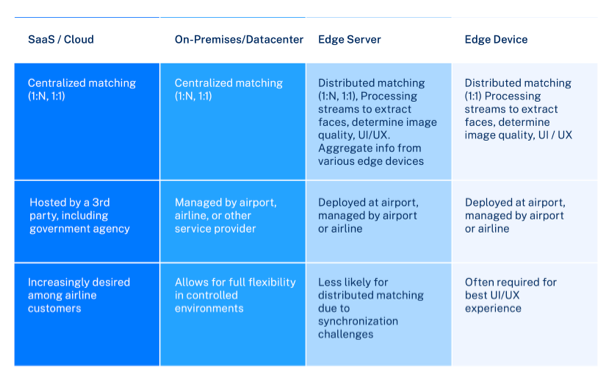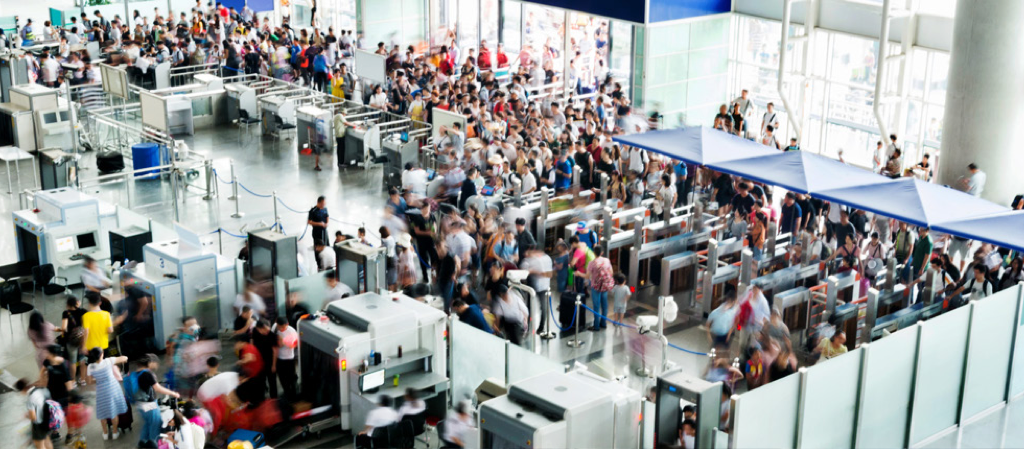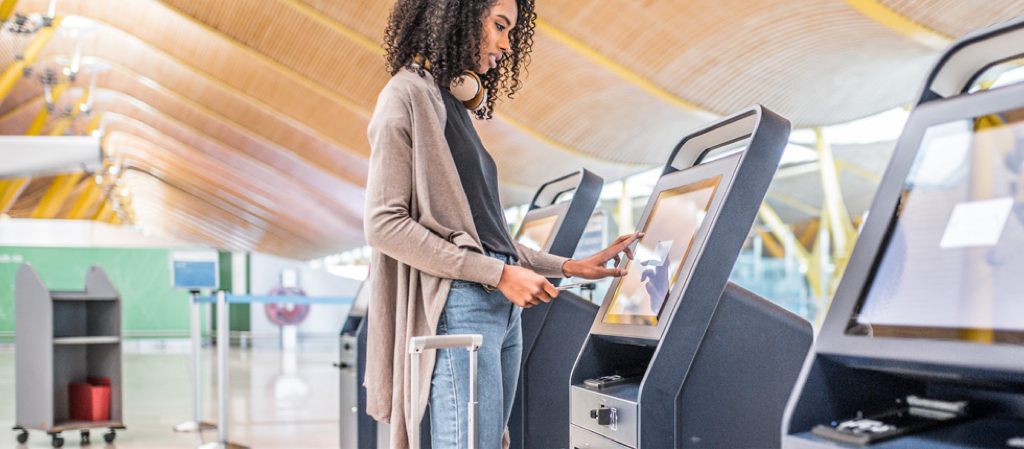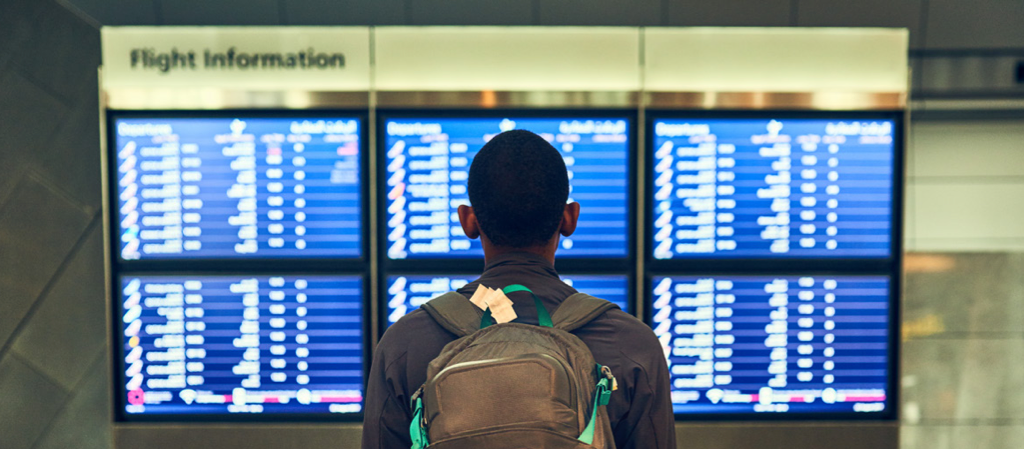White Paper: Face Recognition and the Future Air Travel Experience

This document will explore biometric travel solutions and the technologies, user experiences, and face recognition technology use cases powered by the latest generation of AI-based face recognition.
Introduction
Airports uniquely demand both a very high passenger throughput and a very high degree of security underpinned by the positive identity confirmation of those passengers. At multiple points throughout the air travel experience, traveler identity must be confirmed to meet commercial policy, physical security, or national security requirements.
This uncommon set of demands has forced innovation in the form of automated identity confirmation, primarily using biometrics. For two decades, some combination of face, fingerprint, and iris recognition has been deployed in an effort to speed up identity confirmation, with the goal of creating a secure and frictionless airport passenger experience. Thanks to rapid advances in Artificial Intelligence and specific technologies like Deep Learning and Convolutional Neural Networks, face recognition, in particular, has dramatically improved in the last few years. This allows for cost-effective, intuitive, accurate, and robust solutions in a way that wasn’t possible before.
Face Recognition Technology Considerations for Biometric Travel Solutions
Before discussing the various travel touchpoints and use cases in the airport environment, it is valuable to outline some fundamental technical considerations for the deployment of face recognition in the airport. Specifically, we will address how and where face recognition software is deployed as well as how cameras can be deployed to enable face recognition.
Processing Approaches
Face recognition software can be deployed anywhere along a spectrum of computing platforms, from the cloud to the devices at the edge of the network. The following table outlines common approaches to processing, along with some of the key considerations.

Camera Approaches
Just as face recognition software can be deployed in a number of ways, camera technologies can also be embodied in a number of approaches to address different use cases, cost considerations, and user experiences. Some of the typical camera approaches include:
Embedded Camera
Increasingly, cameras embedded into smartphones, tablets, and laptops have become a viable alternative for biometric authentication. These are enabling at-home or in-office enrollment, and in some cases, are powering ultra-low-cost solutions in-airport. While these offer the benefits of high camera performance and integrated UI, they do entail substantial limitations in terms of form factor, remote software maintenance, supplemental illumination, and advanced camera technologies for liveness and anti-spoofing.
USB Peripheral
Just as embedded cameras have dramatically increased in performance, so too have USB-connected cameras (such as webcams and “block” cameras). Image quality is significantly improved, and options for multi-wavelength imaging and depth-sensing for liveness and anti-spoofing have become commoditized. USB peripherals can be deployed on desktop, in kiosk, eGate, or other integrated devices. However, in many cases, commodity USB cameras do not have configurable optics and Field-of-View, which should be taken into consideration.
Integrated Camera with UI
An increasing number of vendors offer fully integrated face recognition-oriented cameras that have image sensing, display, and supplemental illumination fully integrated into the device. While such solutions typically come at a price premium relative to separate components, they do offer benefits around tailored user experience and optics that have been selected and optimized for face recognition use cases. Processor platform, OS options, and software customization should all be reviewed if considering this approach.
IP-Connected Camera
Traditionally, IP cameras were not considered viable for face recognition due to a combination of poor image quality and the ineffectiveness of face recognition at a distance. However, with dramatic image quality improvements in recent camera generations (including improved color rendering, low-light performance, and WDR / HDR) combined with the dramatic improvement of AI-based face recognition, this is now a viable approach for air travel. Integration with UI, liveness, and traveler facilitation systems are all challenges to deploying such technology. However, IP-connected cameras do now offer the ability to consider completely frictionless / gate-free traveler identity solutions in a way that was only conceptually possible in the past.
Key Touchpoints and Experiences for Biometric Travel Solutions
The camera and processing technologies described above can be deployed for traveler identity verification in a wide range of traveler touchpoints and experiences:
Countertop
The traditional position for interaction between passengers and airlines, airports, and government agencies for identity verification, countertops are increasingly vanishing as automation takes over. However, deployment of face recognition technology is viable at the countertop with any combination of the camera technologies noted above, including mobile devices.
Kiosk
Kiosks have proliferated in airports in recent years, especially for self-service check-in and immigration processing (and to a lesser extent, self bag drop). With integrated processing, UI, and travel / identity document scanning, kiosks are a natural launch point for the evolution to self-service face recognition with the addition of USB-based camera technologies.
eGate
For automated border crossing, automated self-service boarding, lounge access, and other frictionless travel automation, eGates have become broadly popular and effective, often including integrated face recognition technology. Today’s face recognition offers the speed and robustness to provide a nearly on-the-move experience, not unlike metro train turnstile ticket readers.
Seamless Travel
For years, truly seamless, on-the-move identification and authentication has been a dream of the air travel industry. The goal of knowing “who is who” without stopping or even slowing passengers is now becoming a distinct reality with the latest generation of AI-based face recognition, person tracking, and associated computer vision and tight integration with IP-connected cameras.
Mobile
Mobile devices have become a critical enabling capability for establishing and verifying biometric identity in air travel. Whether facilitating document scanning and self-service enrollment at home or giving air travel organizations a new tool for easy, compact face capture, mobile devices have been a game-changer.
Biometric Travel Use Cases
Registration – At Home / In Office
Traditionally, registration for a biometric-enabled travel program was required to take place on-site, either at an airport, government office, or authorized 3rd party location. However, with the evolution of certain key technologies (including mobile face image quality and liveness toolsets, OCR / document scanning, and PKI and other trust-verification techniques) registration at home or in the office for biometric travel programs has become viable. In addition, even when registration requires presence in a trusted location or by a trusted party, the same evolution of mobile technologies enables increased options for registration, reduced overhead for participating agencies, and a simpler process for all involved.
The implications of mobile onboarding for air travel are substantial. While all authorized air travelers already carry a face image on their machine-readable travel document (MRTD) or other authorized identity documents, these images are not necessarily well-suited to biometric matching and may be limited to 1:1 verification applications. Mobile registration can therefore enable improved biometric image quality as well as integration with opt-in biometric travel programs that require backend matching and / or 1:N matching.
Check-In / Bag Drop
Check-in and bag drop in air travel have already been dramatically transformed by the conversion from countertop processing to kiosk-based self-service. As noted previously, kiosks provide an ideal touchpoint for integration of face recognition due to the already-integrated compute platform and user interface.
At check-in / bag drop, face recognition can enhance the air travel experience in a number of ways:
-
-
- For travelers who have not yet registered, or for service providers who do not offer mobile enrollment, kiosks can provide an opportunity for high-quality biometric registration in a controlled environment, optionally tied to document scanning and advanced camera technologies, and supported by on-the-ground staff members.
- For travelers who have already registered, face recognition can eliminate one or more steps in the check-in process, which can be cumbersome and frustrating. Instead of using a record locator or identifying document, travelers can simply look at the kiosk and receive a personalized experience.
- While automated self-bag drop is still a nascent capability, face recognition can enable a secure link between a traveler and his or her baggage when checked. Even for traditional bag drop, a rapid face recognition check could remove the burden of a manual traveler identity check on travelers and baggage handlers alike.
-
Pre-Board Screening (Security Checkpoint)
There is perhaps no more frustrating point in the air travel experience than pre-board screening (a.k.a. “The security checkpoint”). Long lines, confusion, removal of personal items, and feelings of stress dominate the experience, leaving travelers exhausted when they finally reach the gate. Several programs leveraging risk-based screening and / or VIP lanes have mitigated frustration, but such programs are reaching their own limits given current approaches.
In pre-board screening, face recognition can help in a few ways:
-
-
- Face recognition can be used to rapidly validate the identity of individuals who are or are not enrolled in trusted traveler schemes (using either an enrollment database or validation against a travel document, respectively). Automating identity checks can remove a critical bottleneck and point of stress, allowing security officers to focus on high-risk travelers or anomalous behavior. eGate or even “Seamless” approaches to face recognition can further enhance the experience for trusted travelers, increasing the appeal of such programs for travelers who are registered or considering registration.
- Automating identity checks can also close a security gap that currently exists in trusted traveler schemes: assuring the identity of individuals entering the secure area. Today, the schemes typically rely on human identification, which is less-than-optimal, especially over long shifts and repeated tasks.
-
Borders and Immigration
Due to the historically very long lines at immigration processing, and the presence of recognition-quality face images on latest-generation electronic Machine Readable Travel Documents (eMRTDs), borders were a natural place for biometric identity verification systems to first take hold in the airport. Programs throughout Europe, Asia, Oceana, and South America have relied on face recognition to deliver rapid, automated processing through immigration eGates for the better part of a decade. Pockets—especially in the Middle East and Asia—have relied on iris recognition. And the US has historically relied on fingerprint recognition for its Global Entry program. But more and more—especially the US—are turning toward face recognition due to the very high accuracy, throughput, and usability of latest-generation systems. Europe and Australia, both leaders in the use of first-generation face recognition eGates, are now exploring fully seamless, on-the-move biometric authentication with face recognition.
In the US, immigration and borders are intersecting heavily with automated, self-service biometric boarding. Specifically, the US Department of Homeland Security has mandated the use of face recognition for biometric exit processing, with the technology to be deployed for dual-use at airplane boarding. Insofar, immigration processing becomes much more secure (today, there is no exit processing), and travelers get a rapid, ticketless, next-generation auto-boarding solution.
Wayfinding
While many of the applications here utilize face recognition to achieve a specific security, policy, or efficiency benefit, biometric identification and authentication can be used purely to deliver an improved traveler experience. Such is the case with wayfinding. For many travelers who are stressed or tired, locating flight information on a departure timetable can be frustrating or overwhelming. In other cases, confusion can lead to the wrong gate or a misunderstanding of time.
Here, face recognition can be used to tailor what is displayed on a screen, linking to a traveler’s identity. Information can be displayed clearly and concisely, removing confusion and frustration and achieving the goal of making the travel experience more personal. No doubt, with many people moving through an environment and potentially looking at screens simultaneously, some ingenuity would need to be applied to deliver a compelling experience. However, the technology now exists to make this a possibility, with cost-effective face recognition cameras capable of identifying travelers at distance with a high level of confidence (even among all people in a terminal).
VIP Lounge Acces
VIP lounges offer an ideal touchpoint for creating a frictionless, welcoming traveler experience using face recognition. VIP members expect to feel welcomed. They want to enter an oasis in the midst of busy and stressful travel, and don’t want to wait in line or have confusion about access privileges along the way.
Face recognition could be deployed in VIP lounges in several ways, depending on the lounge’s configuration:
-
-
- Integration with eGates for large / high-throughput locations with a similar experience to immigration or boarding.
- Integration with desk-based or even standing personnel. In this configuration, remote IP-connected cameras or desktop-based cameras could be used to image VIP members as they enter the area, automatically bringing up member information for the host to use. With this information on desktop or tablet, the host can seamlessly welcome the member into the lounge, not only allowing rapid entry, but adding a personal touch along the way.
-
Such a scheme could be deployed as a part of an overall biometric travel initiative, or as a purely standalone capability tied to lounge membership. Either approach could benefit from mobile enrollment as identified above, making registration and access equally frictionless.
Boarding
Automated, self-service boarding solutions have been successfully deployed for years, enabling travelers to scan their own travel documents at a purpose-built optical turnstile, gaining rapid access to the aircraft while allowing staff members to focus on outlier cases or travelers who need manual assistance.
The evolution from self-boarding to biometric, ticketless self-boarding is natural from a user perspective, technology perspective, and policy perspective. As noted above, the US has rapidly progressed in this regard, leveraging biometric boarding to enable simultaneous exit immigration processing. In many cases, face recognition is now arguably faster and easier than traditional ticket scanning. Even since biometric boarding began to be deployed in volume, AI has continued to enable dramatic improvement in the accuracy of leading solutions, leading to both better consistency and higher throughput.
The recipe for a successful broad-scale deployment of biometric boarding is now clear:
-
-
- Deliver a travel experience that is superior to ticketed boarding.
- Deliver a value proposition to airlines and airports that is superior to manual, ticketed boarding.
- Deliver a compelling opt-in process and clearly articulated data use policy that makes all involved comfortable with the system.
-
More information
For more detailed documentation, or to schedule a technical introduction to evaluate and integrate Paravision’s computer vision toolset, please contact us at paravision.ai/contact or read more at paravision.ai/applications/travel-and-borders.


